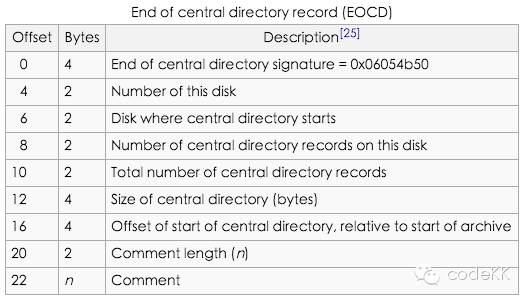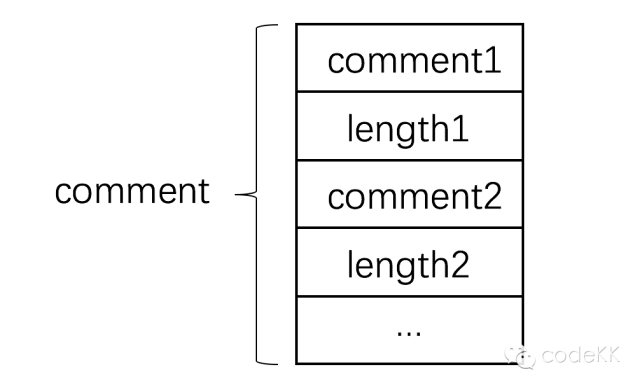1.背景
我们在日常使用应用可能会遇到以下场景。
场景1: 用户浏览 H5 页面时,通过该页面下载链接下载安装 App,启动会来到首页而不是用户之前浏览的 H5 页面,造成使用场景的割裂。
场景2: 用户通过二维码把一个页面分享出去,没有装猫客的用户如果直接安装启动后,无法回到分享的页面。
如果用户在当前页面下载了应用,安装之后直接跳转到刚才浏览的界面,不仅可以将这一部分流量引回客户端,还可以让用户获得完整的用户体验。下面提出一种方案来满足这个业务需求。
2.原理
Android 使用的 Apk 包的压缩方式是 zip,与 zip 有相同的文件结构,在 zip 文件的末尾有一个 Central Directory Record 区域,其末尾包含一个 File comment 区域,可以存放一些数据,所以 File comment 是 zip 文件一部分,如果可以正确的修改这个部分,就可以在不破坏压缩包、不用重新打包的的前提下快速的给 Apk 文件写入自己想要的数据。
comment 是在 Central Directory Record 末尾储存的,可以将数据直接写在这里,下表是 header 末尾的结构。

从表中可以看到定义 comment 长度的字段位于 comment 之前,当我们从文件最后开始读取时,由于 comment 数据是不确定的,我们无法知道它的长度,从而也无法从 zip 中直接获取 Comment length。
这里我们需要自定义 comment,在自定义 comment 内容的后面添加一个区域储存 comment 的长度,结构如下图。

这里可以将一个固定的结构写在 comment 中,然后根据自定义的长度分区获取每个部分的内容,还可以添加其它数据,如校验码、版本等。
3.实现
服务端将数据写入 Apk 的 comment
这一部分可以在本地或服务端进行,需要定义一个长度为 2 的 byte[] 来储存 comment 的长度,直接使用 Java 的 api 就可以把 comment 和 comment 的长度写到 Apk 的末尾,代码如下:
public static void writeApk(File file, String comment) {
ZipFile zipFile = null;
ByteArrayOutputStream outputStream = null;
RandomAccessFile accessFile = null;
try {
zipFile = new ZipFile(file);
String zipComment = zipFile.getComment();
if (zipComment != null) {
return;
}
byte[] byteComment = comment.getBytes();
outputStream = new ByteArrayOutputStream();
outputStream.write(byteComment);
outputStream.write(short2Stream((short) byteComment.length));
byte[] data = outputStream.toByteArray();
accessFile = new RandomAccessFile(file, "rw");
accessFile.seek(file.length() - 2);
accessFile.write(short2Stream((short) data.length));
accessFile.write(data);
} catch (IOException e) {
e.printStackTrace();
} finally {
try {
if (zipFile != null) {
zipFile.close();
}
if (outputStream != null) {
outputStream.close();
}
if (accessFile != null) {
accessFile.close();
}
} catch (Exception e) {
}
}}Apk 中读取 comment 数据
首先获取 Apk 的路径,通过 context 中的 getPackageCodePath() 方法就可以获取,代码如下:
public static String getPackagePath(Context context) {
if (context != null) {
return context.getPackageCodePath();
}
return null;
}获取 Apk 路径之后就可以读取 comment 的内容了,这里不能直接使用 ZipFile中的getComment() 方法直接获取 comment,因为这个方法是 Java7 中的方法,在 android4.4 之前是不支持 Java7 的,所以我们需要自己去读取 Apk 文件中的 comment。
首先根据之前自定义的结构,先读取写在最后的 comment 的长度,根据这个长度,才可以获取真正 comment 的内容,代码如下:
public static String readApk(File file) {
byte[] bytes = null;
try {
RandomAccessFile accessFile = new RandomAccessFile(file, "r");
long index = accessFile.length();
bytes = new byte[2];
index = index - bytes.length;
accessFile.seek(index);
accessFile.readFully(bytes);
int contentLength = stream2Short(bytes, 0);
bytes = new byte[contentLength];
index = index - bytes.length;
accessFile.seek(index);
accessFile.readFully(bytes);
return new String(bytes, "utf-8");
} catch (FileNotFoundException e) {
e.printStackTrace();
} catch (IOException e) {
e.printStackTrace();
}
return null;
}这里的 stream2Short() 和 short2Stream() 参考了 MultiChannelPackageTool 中的方法。
测试
在生成 Apk 后,调用下面的代码写入我们想要的数据,
File file = new File("app-debug.apk");
writeApk(file, "test comment");直接取到数据。
结论
通过修改 comment 将数据传递给 App 的方案是可行的,由于是修改 Apk 自有的数据,并不会对 Apk 造成破坏,修改后可以正常安装。
这种方案不用重新打包 Apk,并且在服务端只是写文件的操作,效率很高,可以适用于动态生成 Apk 的场景。
可以通过这个方案进行 H5 到 App 的引流,用户操作不会产生割裂感,保证用户体验的统一。
参考
https://github.com/mcxiaoke/packer-ng-plugin
https://github.com/seven456/MultiChannelPackageTool
以上两个开源项目都是利用同样的原理实现 Android 快速打渠道包
转自: link



